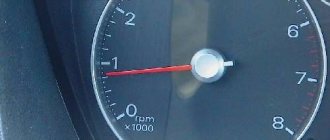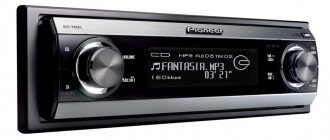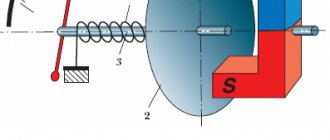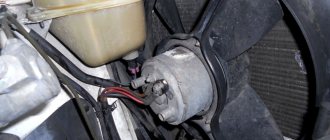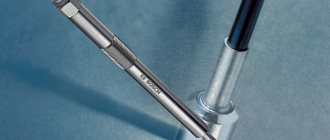Simply put, when unusual sounds appear in the engine that were not previously heard, the intervention of experienced professionals is required, and the first thing they should do is conduct a thorough diagnosis of the car’s power unit at a car service center. The problem, most often, lies in the connecting rod and piston group, and in this case a major overhaul of the car will be required. The reason for the knocking sound is engine crankshaft play.
More common causes of excessively loud engine idling include:
- The electronic engine control unit increases speed to prevent engine stalling.
- Increased clearances are also one of the reasons for the increased noise of a running engine. Such increased gaps between the surface of the cylinders and pistons contribute to increased load on the units and, naturally, noise. When the parts heat up while the engine warms up, the gaps decrease and the noise subsides.
- If the car has a significant mileage of over 100,000 km, the cause of the unusual sound may be hydraulic compensators. Coking of the channels can become an obstacle to the operation of the oil pump and the flow of oil into the engine. At the same time, a characteristic “clatter” is heard, which decreases as the engine warms up and then disappears.
An increase in the engine speed of a cold engine occurs by enriching the fuel mixture. This compensates for unburned fuel, the cause of which is the reduced engine temperature. In addition, increased speed is necessary for stability of operation and sufficient lubrication of the rubbing surfaces of parts, since, due to the increased viscosity of the oil at low temperatures, the operation of the oil pump is difficult.
An increase in the number of revolutions during warm-up is also necessary to quickly achieve the optimal temperature of the catalyst and reduce the toxicity of exhaust gases.
As the engine temperature rises, the control unit reduces speed and the noise becomes weaker. Reducing noise after warming up also helps to reduce clearances and reduce oil viscosity. Therefore, increased noise when the engine warms up is not a sign of a car malfunction.
Faults that increase engine noise
When unnatural sounds appear in a running engine, the driver tries to understand their cause and, when he comes to a certain conclusion, seeks to fix the problem on his own or involve his friends who have the necessary experience.
The most significant malfunctions that cause unusual noise in a running engine:
- Use of low quality oils and fuel;
- Malfunctions of the lubrication system;
- Inappropriate temperature conditions;
- Problems with the ignition system;
- Worn timing belt;
- Malfunction of hydraulic compensators;
- Problems in the timing belt;
- Unstable operation of the idle speed controller;
- Malfunction of electrical systems.
So many malfunctions that are caused by extraneous or more powerful noises from the power unit can only be sorted out by a car service specialist, and that is where you should go.
Delay in this case will result in serious damage and the need for an expensive overhaul of the engine,
Motor diagnostics by ear: cutting off extraneous sounds
Engine noise can say a lot
It is important to remember that in order to correctly diagnose knocks and noises, the car’s power plant must warm up to 80–85 degrees after starting, otherwise the readings can be considered erroneous.
It is best to take measurements not by ear, but with the help of a stethoscope, and preferably modern electronic equipment. Based on the nature and originality of extraneous knocks, it will be easy to determine a specific malfunction.
The sounds due to the weakened fixation of the engine to the body resemble the noise of a motor
Initially, the entire diagnostic process associated with the motor can be divided into several stages. The first of them, wiretapping, is what experienced car enthusiasts do, this is how experts begin their work, this is how beginners try to show what they know about cars.
And in general, the proverb incorrectly advises, at least in this case, “it’s better to see once”... In our case, it would be more accurate to hear once than to see a hundred times, i.e. face the problem head on.
The first thing to do when listening to sounds is to determine, or rather, prove that they are produced by the engine, and not by other components or elements of the car. For example, suspension components, hanging elements that have lost their former fixation, etc. often knock.
Advice. To partially eliminate the noise emitted by the gearbox and transmission, it will be enough to press the clutch pedal.
In the same logical way, you can remove from the list of causes some other sounds not produced by the internal combustion engine. For example, if you shake the power plant from below, you will be able to identify sounds that are associated with mounting the engine to the body or frame.
Sometimes the problem with fastenings is solved by welding metal corners
More interesting points:
- If there is a whistling or buzzing sound, doubts should fall primarily on the alternator or timing belt, camshaft drive or components in the pump area.
- The squealing most likely indicates problems with the belts (jumping), freezing of the pump, lack of lubrication in the generator, etc.
It is clear that by dismantling belts or other elements and filling in the amount of lubricating fluids, you can exclude them from the diagnostic analysis.
Thus, the first and most important thing that is done in the process of diagnosing an automotive power plant is to check its “environment”. The purpose is clear - this proves that the sounds and knocks belong to the engine.
To better understand the nature of problematic car engine sounds, we recommend that you familiarize yourself with them in more detail.
- The sound comes from the top of the engine, reminiscent of the ringing of metal. Typically, this metallic noise indicates problems with the valves. Most likely, this symptom indicates improper valve adjustment or excessive wear. If the noise increases as the speed increases, and even suddenly, the nature of the malfunctions indicates a much broader nature of the sounds - for example, it may be a matter of gaps.
Worn valves indicate an approaching overhaul. - The noise is similar to the quiet friction of iron bars against each other. The sound changes as engine speed increases or decreases. The knocking comes mainly from the front end of the internal combustion engine. Most likely this is a symptom of a weakened timing chain. If the car is equipped with a chain and not a belt, an experienced car owner should be familiar with this sound.
- The noises are low-medium tonality, practically unchanged as the engine speed increases. As a rule, the sounds come from the bottom of the motor. This kind of knocking is more dangerous than others, as it indicates increased wear of the “internals” of the engine.
- Clanking, very loud. Appears more often when accelerating or maneuvering a car. In most cases, it indicates detonation knocks. The sounds are made by the pistons, which absorb the shock wave from the explosion of the combustible mixture. Among experienced car enthusiasts, this noise is usually called “finger tapping.”
Lubrication system problems
An insufficient amount of lubricating fluid in the system leads to a drop in pressure. As a result, the rubbing surfaces of the parts will be without sufficient lubrication, which will lead to their premature wear. It is also unacceptable to use low-quality oils or those that do not correspond to the type of engine, the viscosity of which will not allow high-quality lubrication of the mechanisms. In this case, the increased load on the engine will be accompanied by an increased noise level of its operation.
Another reason for a loud engine is insufficient lubrication of engine parts, which increase in size as the temperature rises and begin to noisily come into contact with other mechanisms and parts of the power unit without lubrication.
The entry of coolant into the lubrication system leads to dilution of the oil and loss of its necessary lubricating properties. At the same time, engine wear significantly exceeds established standards. If coolant gets into the lubrication system, it is necessary to immediately change the oil, filling in the required type for this engine.
Engine knocking: causes and solutions
Each automobile engine has a certain service life, after which major repairs are required, since engine parts wear out over time.
At the same time, various malfunctions occur in the power unit: a knocking sound appears in the engine, blue smoke comes out of the muffler pipe, oil and fuel consumption increases, and power is lost. The nature of engine noise can be different, but there are no frivolous extraneous sounds in the engine, it’s not for nothing that there is a proverb - a good knock will come out.
A knock in an engine is the impact of one part on another. This means very high loads at the points of their collision. Note that impact loads gradually destroy the mating surfaces, and the faster the greater the impact force. And since this force depends on the size of the gap, as it increases, the wear rate of parts increases. In other words, in most cases, knocking (read: shock loads, clearance, wear) progresses, i.e. getting stronger.
A critical increase in the size of the working gaps between internal combustion engine parts leads to knocking noise during engine operation. An indirect sign of the cause of the knocking is its tone, which in most cases makes it possible to determine the source of the sound indicating a malfunction of a particular component. The progression of knocking depends on the technical characteristics of the materials from which the parts are made. When contacting timing parts made of high-strength material wear out, engine knocking does not change in intensity and character for a long time. Extraneous sound quickly intensifies with wear of soft parts working in tandem with elements made of hard material (connecting rod and main bearings, as well as camshaft bearings).
A knocking engine is an unpleasant phenomenon, to say the least, and before continuing to operate the car, it is imperative to find out the cause of the knocking in the engine. Anything can knock in the internal combustion engine, from noise in attachments (bearings of a generator or water pump) to the knocking of connecting rod bearings or pistons.
How to listen to engine knocks?
Specialists diagnose problem nodes by the nature of the knock, its tone and area of localization. A stethoscope is widely used for diagnosis. You can also make your own device for listening to engine knocks. To solve the problem, you will need a steel rod to which you need to solder a metal can. The bottom of such a container will effectively act as a membrane. To determine the cause of the knocking, the end of the rod is applied to various parts of the diagnosed internal combustion engine, while the can is pressed tightly against the ear.
The tone of the sound is an indirect sign, since on different engines the knock may appear louder or muffled. For example, the conventional knock of the crankshaft main bearings on a 1.4-liter Korean car may well be louder and easier to hear compared to the knock of connecting rods on a 3.0-liter German car. Often, the individual design features of each engine can cause a knock that has a different sound color, but the breakdown may be the same. If we talk about diagnostics based on the nature of engine knocking, then it is worth highlighting a constant knocking, periodic knocking with one frequency or another, as well as occasional knocking. In the latter case, it is worth understanding the impacts that occur unevenly. Engine knocking is usually associated with engine speed, that is, with the frequency at which the crankshaft rotates. The faster the engine spins, the higher the knocking frequency. The indicated frequency may or may not coincide with the crankshaft speed. It is also worth noting that the sound can become more or less intense (differ in strength) depending on the operating mode of the internal combustion engine. For example, with an increase in the speed and load on the engine, there is a natural increase in the loads on the moving parts of the crank mechanism and the timing belt. In this case, the worn elements will knock more strongly than when the engine is idling. At this stage, when diagnosing, it is important to determine whether the knocking increases with increasing speed. This often requires experience, since it is necessary to listen for knocking against the background of the general increasing noise of the operating unit. In parallel with this, it is necessary to separately take into account the fact that the oil pressure in the engine lubrication system also increases with increasing speed. In some cases, the engine oil itself acts as a “damper”, and the knocking itself may become less intense even with increased load on the engine. For this reason, an important parameter is the temperature of the internal combustion engine. The engine may knock heavily when hot because the oil is diluted. At the same time, the knocking may hardly appear when cold. The opposite situation also happens when the engine knocks distinctly when cold, but after reaching operating temperature the noise disappears or is minimized.
The noise in the engine is not always constant; often the engine knocks only when it is cold, and when it warms up, the extraneous sounds disappear. Let's consider noise and its manifestations depending on the operating mode of the engine.
Engine knocking when cold
You start a cold engine and it runs with a slight knock, but when it warms up, the noise disappears. There are many reasons, but the main thing is that it’s not scary, you can drive, but you definitely need to warm up the engine before driving. Why does the engine make noise when it’s cold, but when it warms up the noise disappears? Because the engine has natural wear and tear on parts, but when it warms up, the parts expand and take on normal clearances.
Most often, engine knocking when cold occurs due to weak pistons in the cylinders. This phenomenon occurs for the following reason:
- there is wear in the cylinder liners, and a gap is formed between the piston and the cylinder wall that is larger than the permissible norm;
- the pistons are made of aluminum, and, as you know, this metal expands greatly when heated;
- As the power unit warms up, the gap between the cylinder and the piston decreases, and when hot it almost disappears.
Often the timing chain makes noise when it is cold, and as it warms up the noise disappears. In systems with a hydraulic chain tensioning system, oil pressure may not be immediately supplied to the timing parts, which is why noise occurs when cold. For the same reason, hydraulic compensators can knock, and the sounds disappear when the engine is hot. But often, when the internal combustion engine is warm, the hydraulic compensators continue to click, and in this case they must be replaced.
Knocking in the engine when hot
It often happens the other way around - an unheated engine runs quietly, but when it warms up it starts to knock. This phenomenon does not bode well, since the crankshaft or piston group parts knock in a similar way. Everything is explained quite simply:
- while the engine is cold, the engine oil is thick, and the gaps in the rubbing parts do not manifest themselves in any way;
- As the internal combustion engine warms up, the oil thins out and a knocking sound appears in worn parts.
- When the engine is hot, knocking occurs:
- in main bearings - with an increased gap between the main bearings and the crankshaft journals;
- in connecting rod bearings with slight wear of the connecting rod journals of the crankshaft - if the gap between the connecting rod bearing and the crankpin journal is already large, a metallic knock is heard in the engine regardless of the heating of the internal combustion engine;
- with a cracked piston pin;
- with existing cracks in the piston skirt.
It is unlikely that anything can be done on the spot with an engine knocking on the road. You can check the oil level - lack of lubrication is most often associated with damage to parts that cause knocking. As a rule, after adding oil to the nominal level, the knocking in the engine stopped.
Next, you should find out two things: whether the knocking intensifies under load and how quickly it progresses over time of movement. If the answers are positive, then the crankshaft bearings are most likely damaged. It is dangerous to drive further with such a defect - the engine will soon be disabled with the prospect of repair.
A knocking sound occurs in the engine when low-quality fuel is added or after refueling at a questionable gas station. It is recommended to either add an additive that increases the knock resistance of gasoline or add high-quality fuel at a proven gas station.
Engine knocking at idle
The engine can only make noise at idle, and as the speed increases, the sound disappears (in other cases completely, in others it becomes barely audible). As a rule, knocking in the engine at idle speed is not too dangerous, but it is still necessary to find out the cause of its occurrence. Why is there noise at idle?
- touches the generator or pump pulley;
- the timing case or engine protection vibrates;
- there is play in the cam gears (if the engine has a gear transmission);
- The crankshaft pulley has come loose.
It's worse when a crack appears in the flywheel on a car with an automatic transmission, and this sometimes happens. But on an engine with a manual transmission, the flywheel is unlikely to burst, it is quite massive. The fastening of the camshaft sprocket (gear) may also become loose; also, at idle, noise is created by a loosened camshaft gear on the key.
Is it possible to distinguish engine noises depending on their source? Specialists are capable of solving such problems.
If the pistons knock
In the cylinder-piston group, parts wear out during the operation of the car, and most often various noises arise due to the increased gap between the piston and the cylinder itself. The appearance of a gap of 0.3 - 0.4 mm leads to the appearance of piston knocking in the cylinder. But often defects appear due to careless operation; the piston group tolerates overheating very poorly.
A dull tone of sound, reminiscent of tapping on pottery, indicates that the problem is localized in the cylinder block. Extraneous noise may sometimes be accompanied by clicking sounds.
Piston knocking most often occurs when the engine is cold, as well as at low speeds or when the gas pedal is suddenly released while driving. A knock of this origin disappears when the engine heats up due to thermal expansion of the piston.
If the piston pins are knocking
The piston pins knock loudly and high in tone, the knock is clearly metallic. It is clearly audible when changing the gas, as well as at the moment of releasing the gas or pressing the accelerator to accelerate. The localization zone is the cylinder block. Usually appear when there is a gap of about 0.1 mm. Additionally, the malfunction is diagnosed by unscrewing the spark plug. With the spark plugs removed, fuel combustion in the cylinder does not occur, which means there is no load on the piston. Let us add that such a knock also occurs as a result of using fuel that is unsuitable for this type of engine (detonation), as well as with a significant load on the engine at low crankshaft speeds (driving uphill in high gear).
Knock of crankshaft liners
Wear of the crankshaft main bearings results in a slightly muffled metallic noise localized in the area of the engine crankcase. An extraneous sound is heard with a sharp increase in speed, a sharp release of gas, as well as at low speeds when the engine is warm (low engine oil pressure). The use of low-quality motor oil that does not meet the requirements for the engine in use can also cause crankshaft knocking. In this case, an urgent oil change is necessary with mandatory flushing of the lubrication system.
It should be noted that the crankshaft can also suddenly start knocking due to the use of low-quality motor oil or a lubricant that does not meet the manufacturer’s tolerances for this type of internal combustion engine. In this case, the oil must be changed immediately, and the lubrication system must be flushed before replacement.
Knock of connecting rod bearings
When the connecting rod bearings wear out, the sound is in many ways similar to the noise when the main bearings fail, being more distinct. Knocks in the crank mechanism (crank mechanism) are among the most serious that can be found in an engine, and a car cannot be operated with a knocking crank mechanism due to the high risk of engine jamming.
A sharply increasing sound intensity when the crankshaft speed changes indicates the need for urgent repairs. When a knock of this kind appears in the engine, the engine should be turned off and not started again - it is necessary to remove the power unit and overhaul it. If you continue to operate the car, the crankshaft will very quickly become deformed, and then it will no longer be possible to polish it - the crankshaft will have to be replaced. There are drivers who stubbornly continue to drive with knocking connecting rod bearings; as a result, the cover comes off the connecting rod and the cylinder block is punctured. The consequences are very sad - the entire engine must be replaced, since repairing it can cost more than a new power unit.
The knock of the connecting rod journals is always sharp, metallic, it is clearly audible when the throttle valve is opened sharply - usually accompanied by a drop in oil pressure. If there is no pressure at all in the oil system, the crankshaft should jam very quickly; it may not be enough for even 15 minutes of operation. It should also be noted that in other cases it is enough to drive 50-100 km with connecting rod knocking to render the engine completely unusable.
The crankshaft journals knock differently, at low tones, with vibration throughout the engine. Moreover, there are options:
- knocking occurs due to general wear of the main journals - a large gap is formed between the crankshaft journals and the cylinder block supports;
- Due to insufficient oil pressure on one or more journals of the shaft, scoring occurs on them.
Driving with worn main shaft journals is not as scary as driving with knocking connecting rod bearings, but it’s still not worth operating a car with such a defect, and the sooner the car comes in for repairs, the better.
Noises in the gas distribution mechanism
A rather unpleasant phenomenon is valve knocking; valve clicking can occur both in engines with hydraulic compensators and in internal combustion engines with mechanically driven valves. If the hydraulic compensator no longer maintains oil pressure, you can try to remove it and wash it, but washing does not always help, and in many cases it is easier and simpler to replace hydraulic tappets than to go through the hassle of repairing them.
When valve knocking occurs in an engine with a mechanical valve drive, first of all it is necessary to adjust the valves - adjustment can be done in different ways, depending on the design features of the mechanism. For example, on front-wheel drive VAZ cars (2108-09, 2110-12, Lada Priora\Kalina), the valves are adjusted by selecting the thickness of the shims; on ZMZ engines, the adjustment is made using screws.
Valve knocking can occur not only due to unadjusted valve clearances; there are other reasons:
- the camshaft cam is worn;
- there is a gap between the pusher and its seat;
- there is wear on the valve end (one or more);
- Adjusting washers are worn.
The gas distribution mechanism may also make noise:
- valve train chain;
- tension rollers.
When you experience engine knocking, the first thing you need to do is check the engine oil level. The appearance of a knock may well be due to a drop in pressure in the lubrication system. If everything is in order with the level, then at the initial stage it will be necessary to more accurately localize the fault, eliminating possible knocking noises from fuel equipment, drives, attachment pulleys, etc. Next, it is necessary to determine the nature of the knock, and also confirm or refute the fact that it intensifies under load. If, as the load on the internal combustion engine increases, the engine knocks more strongly, then most likely the problems have arisen in the crankshaft and the CPG.
If the knocking frequency is two times different from the crankshaft speed, then there are likely problems with the timing belt. This is because the crankshaft rotates twice as fast as the camshaft. Warming up the engine in such a case can lead to increased knocking, since with increasing temperature the valve clearances increase. As for the load on the internal combustion engine, the knock of the gas distribution mechanism usually does not depend on the operating mode of the engine. An exception may be hydraulic compensators, which knock more intensely under load.
A knock that appears in the engine is an urgent reason for diagnosis. The scope of repair work depends on the correct diagnosis: it is possible that to eliminate the knocking it is necessary to remove and completely disassemble the engine, although it cannot be ruled out that only partial disassembly is required, or the cause of the knocking is not related to the engine.
To ensure that the motor does not fail prematurely, maintenance should be carried out regularly. The engine oil and oil filter should be replaced after ten to fifteen thousand kilometers; on diesel engines, replacement is required more often - after 7.5-10 thousand km. If the car operates in difficult road conditions, the oil must be changed more often, since due to increased friction of parts it quickly darkens and loses its lubricating properties.
The most famous “knocking” motors.
1.6-liter Volkswagen Polo engine
The Kaluga-assembled Volkswagen Polo is equipped with 1.6-liter power units in three modifications; the first to be installed on the car (since 2010) were 4-cylinder internal combustion engines of the EA111 (CFNA) series with a capacity of 105 hp. With. The CFNA internal combustion engine is 16-valve, does not have a timing system, and is equipped with a chain drive.
The main problem of this engine is the knocking of the pistons on a cold engine; it arises due to the design features of the CPG. It is quite difficult to combat this phenomenon, and it does not make much sense - the noise does not affect the operation of the engine, especially since the sound disappears when it is hot. Over time, hydraulic compensators may begin to knock in the engine, but this happens infrequently, and this is not a “disease” of this power unit.
Renault diesel engines
Four-cylinder DCi diesel engines with a volume of 1.5/1.9/2.2 liters, produced from 2001 to 2009, are not very reliable. The main problem with these power units is the knocking noise that occurs in the crank mechanism. These motors must not be overheated or overloaded; the engine oil must be changed promptly. The K9K 1.5 liter internal combustion engine is considered the weakest; it can turn the connecting rod bearings already at a mileage of 130-150 thousand km.
It should be noted that gasoline engines are much more reliable - the crank mechanism is problem-free, and the crankshaft fails on them only when starved of oil or when using low-quality engine oil.
Cooling system
The cause of premature detonation may be exceeding the permissible engine temperature due to damage to the thermostat. With such a malfunction, coolant will not flow into the radiator in sufficient quantity, which will lead to engine overheating.
If the thermostat breaks down, it is also possible for excess coolant to enter the radiator, which leads to an increased noise level of its operation. This malfunction can be eliminated by cleaning the thermostat or replacing it.
Muffler malfunction
The exhaust system of a car consists of many parts, and noise suppression starts from the engine. The more mileage a car has, the more wear and tear it wears on its exhaust system. Most often, the gasket between the muffler and the engine fails. For this reason, the noise level increases. To eliminate a malfunction of the exhaust system, in most cases it is necessary, having established the cause, to eliminate it by bringing the muffler into working condition, welding the defects, or replacing the gaskets or muffler.
Wheel bearing - metallic monotonous sound
If any bearing fails, there will be a constant monotonous hum, which intensifies at speed. The wheel bearing is the most common type of failure of these structural elements of a car. On poor roads and under high loads, such parts do not work for too long. Installing non-original bearings does not guarantee durability at all. Replacing a wheel bearing is quite difficult:
- first you need to determine whether it is the wheel bearing that is really humming;
- To do this, it is enough to jack up the car, place the stops and spin the wheel in fifth gear;
- a spinning wheel will hum after turning off the engine if the bearing is broken;
- Next, you should remove the wheel, disassemble the block of brake elements, unscrew the hub nut;
- after this, the bearing is knocked out, its seating area is cleaned and lubricated;
- in the last stage, a pre-lubricated new wheel bearing is installed;
- all systems are carefully assembled back without any changes in design;
- After installation, the bearing is checked in the same way as the old one was checked.
If the hum disappears, then the right decision has been made. But wheel bearings are quite tricky parts to diagnose. These elements in a modern car can hum just like other bearings in the structure. Also, a hum can occur due to wear on the wheel seats, and sometimes low-quality tires hum when they come into contact with an asphalt surface. So it’s simply impossible to make an unambiguous conclusion based on the sound from the front end.
Hydraulic compensator noise
At idle, an unheated engine makes noise most often due to hydraulic compensators. When replacing worn hydraulic compensators with lightweight new ones, the noise level increases, while gasoline ones make the same noise as diesel ones.
The eight-valve engine produced by VAZ does not have hydraulic compensators. For this reason, such an engine requires periodic valve adjustment. If this is not done, the specific noise during engine operation will increase significantly. The engine with adjusted valves runs almost silently.
Crunch when turning – CV joints and steering knuckles
CV joints are one of the most common reasons for car owners in Russia to visit a workshop. The turning mechanisms in the wheels of both foreign and domestic cars break down. The cost of replacement parts is quite high, so it is better to proactively check the reliability and quality of the CV joint when servicing vehicles and at every convenient opportunity. To check the performance of the CV joints, perform simple steps:
- turn the wheels completely to the right and examine the right boot of the outer CV joint for damage;
- then carry out the same procedure with the left boot and look at the mount;
- you can simply drive the car into a pit and look at the integrity of all rubber parts;
- then you can check the operation of the CV joint on the go; this will require a large platform;
- Turn the steering wheel as far to the right as possible and slowly accelerate the car in a circle;
- then depress the clutch and turn off the engine to hear the sound of the suspension;
- If at the same time a slight uneven or rhythmic crackling is heard, the CV joint fails.
As you can see, there are a lot of problems in modern cars. But this does not mean that you will spend a lot of money on repairs and maintenance. Most likely, you will be able to repair your car without any difficulties if you fix all the problems on time. This is the only condition for the normal operation of modern transport, which many drivers, unfortunately, violate.
Electrical system problems
Malfunctions of the vehicle's electrical system manifest themselves in unstable engine operation, the formation of a poor-quality air-fuel mixture, and interruptions in the functioning of the cooling, ignition and other systems. With all these malfunctions, the engine noise level exceeds normal, but they do not exhaust the reasons for the increased noise. In particular, such reasons may be worn-out engine mounts, as well as cylinder block gaskets.
Such malfunctions can be eliminated either on your own or by involving car service specialists.
Crankshaft fault
Increased noise levels in both gasoline and diesel engines can be caused by abrasion of the crankshaft bearings or journals, bearing wear, insufficient lubrication, or the penetration of antifreeze or water into the lubrication system.
To summarize, we can say that the main reasons for increased noise levels during engine operation are problems:
- exhaust system;
- gas distribution mechanism;
- generator, including wear of bearings or belt;
- other malfunctions in which the “engine knocked.”
Let's sum it up
Today, there are hundreds of sounds that can be attributed to a variety of suspension, steering, engine or transmission parts. If during diagnostics you cannot find a problem, you will have to check all the details of the engine compartment. For example, a knocking sound when driving can be produced by an engine whose mounting pad has broken. In this case, every time you start, the power unit will deviate and hit the surrounding metal parts, producing a completely unclear and surprising sound.
Often the cause of strange sounds is peripheral equipment, such as a starter or generator that has lost its fastening. The timing belt rollers may knock, and the alternator belt with worn teeth may squeal and squeal when starting the engine. It is better to turn to specialists and get complete answers to your questions than to guess and engage in self-diagnosis. In fact, it turns out that the services of a specialist are much simpler and more profitable for you than any other methods of troubleshooting. How do you solve problems when a car makes various metallic sounds?


